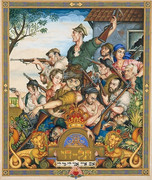There was an archaeology discovery made and announced on the holiday:
When the Hasmoneans returned to the Temple only to discover that the golden menorah was stolen by the Greeks, they quickly put together a makeshift candelabrum with seven lamps using scraps of iron. They lit the menorah using pure oil, according to the story as it is written in the Book of Maccabees.And that's the best part of all; another splendid refutation of Islamist propaganda.
On the eve of Hanukkah in the year 5774 (2013), many generations after the drama which yielded the Festival of Lights unfolded some 2,150 years ago, Dr. Eilat Mazar, an accomplished archaeologist, is recreating her earth-shattering rediscovery of the "lost menorah" at the foot of the Temple Mount. This discovery took place seven months ago but was only revealed in September.
For many years, Mazar has excavated the hidden corners of this land. The ground she dug held thousands of discoveries and archaeological treasures. Still, nothing could have prepared Mazar, the granddaughter of Professor Benjamin Mazar, who is thought of as the pioneer in excavations of artifacts from the biblical era, for the 1,400-year-old discovery, not to mention the reverberating responses, from the prime minister himself to colleagues from abroad to "regular folks," among them Jews and Arabs.
These unforgettable moments are seared into her consciousness. It was the start of the fourth excavation season at the City of David, also known as the Ophel, on the southern rim of the Temple Mount complex. The project is overseen by the Hebrew University.
The area itself was first excavated by her grandfather 40 years ago. During that initial period, the diggers, including students from Ambassador College in Oklahoma, devoted their efforts to removing the uppermost layer of earth from the area designated for excavation. They "uncovered" dozens of plastic cups, aluminum foil, and worn-out old shoes that appear to have been used by construction workers during their lunch breaks. At that stage of the dig, they didn't expect to come across anything special.
Mazar was thus surprised when on the fifth day of her own dig, this past summer, Ariel Winderbaum, the archaeologist in charge of Area C, showed her a large golden earring that was particularly dense. It was uncovered in one of the rooms attached to the structure that hosted the shops in the Byzantine area. From here, things began to unfold quickly. Before Mazar managed to absorb the significance of what had been found, another earring was found nearby. It matched the first earring.
A few minutes later, several golden coins were also found. And minutes afterward more artifacts were uncovered. Mazar was concerned that the news of the golden findings would attracted unwanted guests to the complex. She asked Winderbaum to make sure that the workers who uncovered the 36 coins and earrings -- Cari and Ahinoam -- continue with their work while maintaining strict confidentiality. Mazar herself was quick to leave the vicinity so as not to arouse attention.
Now Mazar is releasing a Hebrew-language book entitled "Discovering the Lost Menorah at the Foot of the Temple Mount." In it, she describes the moments that fired the imagination of archaeologists and millions of Jews from around the world. It also provided yet another rejoinder to the deceitful claims propagated for years by the Palestinians whereby Jewish links to Jerusalem and the existence of the temple are a fallacy.









0 Responses to “Gold treasure on Hanuka”
Post a Comment